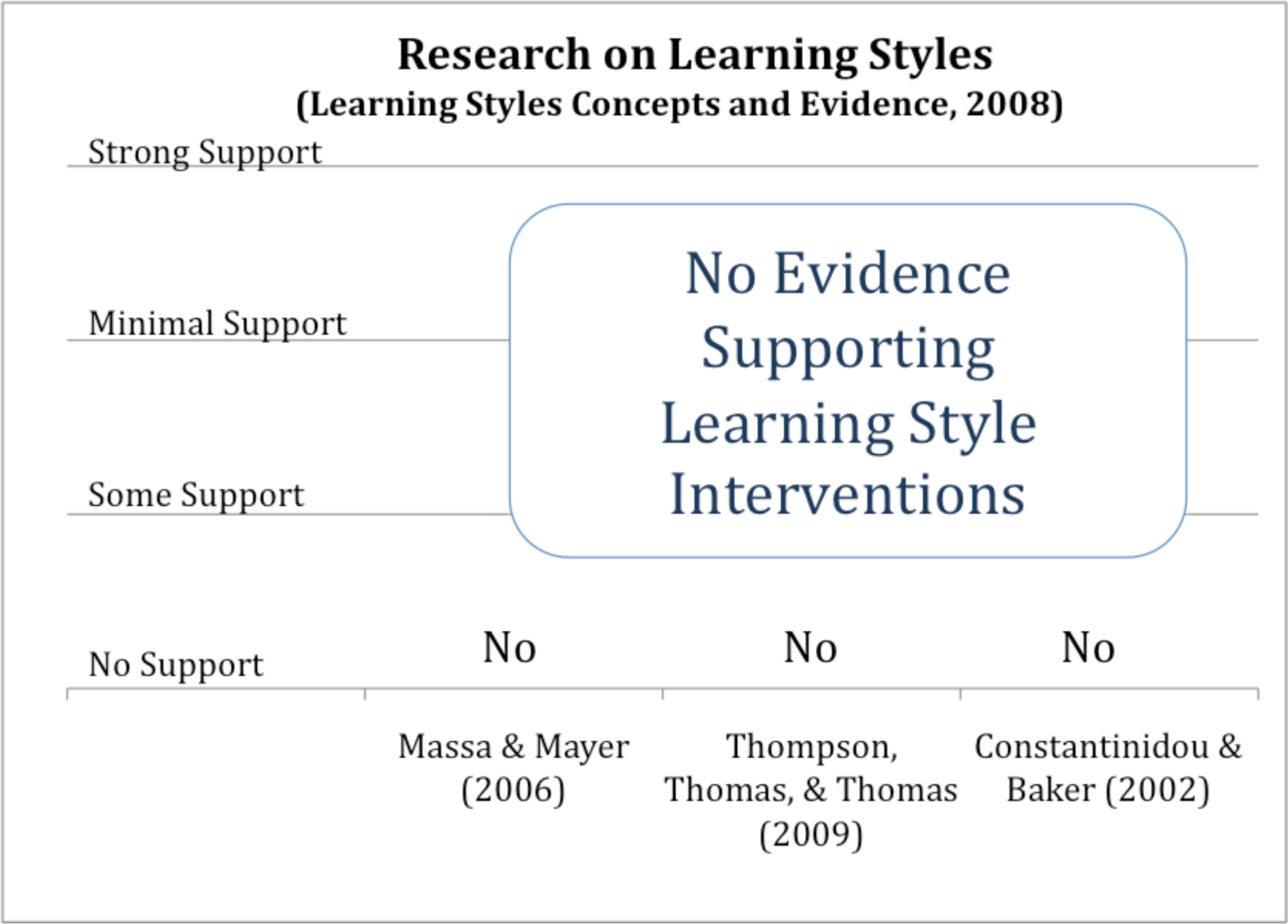Does learning style make a difference?
Why is this question important? Learning style as a method for improving student performance has achieved general acceptance among educators and the public. Its influence in education circles is found at all levels, from kindergarten through graduate school. A thriving industry has grown up devoted to publishing learning style tests and guidebooks for teachers, offering professional development for educators built around the concept, and providing workshops that advise parents on how to select teachers matched to a child’s learning style. All aspects of the industry are based on the assumption that learning style assessment and training make a difference in student performance. If there is no evidence to support learning styles, parents and educators would be well advised to spend time and money on practices that do work.
See further discussion below.

Source(s): Learning Styles: Concepts and Evidence, 2008
Result(s): The available research on the topic offers little evidence to support the development of curriculum, instruction, and assessment packages based on learning styles.
- The study suggested that validation of learning style instruction begins with rigorous research designed to meet the following criteria:
- Students must be divided into two groups based on an assessment of learning styles.
- The students from the two groups must be randomly assigned to receive training in one of multiple instructional methods designed to match a learning style.
- All of the students must be tested at the end of the instructional period.
- Finally, the study must be able to identify a statistically significant difference in student performance based on learning style and instructional methods constructed to match the learning style.
- Despite the existence of a large number of studies on the topic of learning styles, only three studies were identified as meeting the rigorous research criteria:
- Massa and Mayer (2006)
- Thompson, Thomas, and Thomas (2009)
- Constantinidou and Baker (2002)
- The authors concluded the following based on a review of the literature:
- There is ample evidence that children and adults express preferences for how information should be presented.
- There is evidence that people differ in their aptitudes for different kinds of thinking and for processing different types of information.
- There is virtually no evidence to justify incorporating learning style assessments into educational practice.
Implication(s): The study provided the following recommendations to educators and parents:
- Given the pressing need to make timely improvements in the education system, interventions should be selected based on what has been proved to work.
- Given the limited resources available to schools, money should be spent on evidence-based educational practices.
- Given the lack of sound studies of learning styles, further research on learning styles should be conducted, but such research needs to employ rigorous research methods.
The study pointed out that even if the evidence had documented the efficacy of using learning styles interventions, which was clearly not its conclusion, the impact would need to be large and robust to justify taking the practice to scale. A small impact would result in a practice that did not meet the goal of being cost effective. Interventions built around learning styles are potentially expensive in terms of dollars and teacher time. Students must be assessed, grouped by learning style, and given customized instruction designed to match each style.
Author(s): Harold Pashler, Mark McDaniel, Doug Rohrer, and Robert Bjork
Publisher(s): Psychological Science in the Public Interest
Study Description: The study was not designed as a meta-analysis but more closely resembles a literature review, referencing 56 studies on the topic of learning styles. It was funded by Psychological Science in the Public Interest to assess the scientific evidence supporting the application of learning style assessment in schools. To accomplish this task, the study (1) analyzed the concept of learning styles to determine what evidence was needed to justify basing pedagogical choices on assessments of students’ learning styles, and (2) reviewed the literature to see whether evidence supporting the effectiveness of learning style interventions existed.
Definition(s): Learning style: The view that different people learn information in different ways; for example, that some are visual learners and others auditory learners, that some are left-brain students and others right-brain.
Citation: Pashler, H., McDaniel, M., Rohrer, D., and Bjork, R. (2008). Learning Styles. Psychological Science in the Public Interest, 9(3):105-119.
